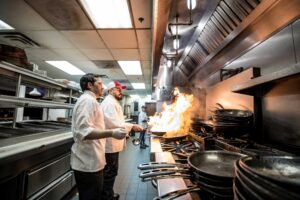
What’s the Best Way to Clean Your Restaurant Hood?
Most kitchens hire a third-party professional hood cleaning service to come on a regular basis. Usually, that’s once a month or quarter depending on local regulations. The service performs a thorough cleaning and places a sticker on the hood certifying that it passes inspection. The problem with this method of hood cleaning is that these services can be expensive, unreliable, and they require you to completely shut down your kitchen while they work. Although they do a good job of eliminating your immediate risk of hood fire, it doesn’t take long for grease to start accumulating again, and there’s significant risk of hood fire in between cleanings.
If fire safety is your concern, an automated exhaust hood cleaning system like AutoMist® is a superior hood cleaning solution. AutoMist cleans your hoods and flues automatically every night — or more, depending on what and how much you cook — so you show up every day to a clean hood and minimal fire risk.
How Often Should I Clean My Hood?
Local regulations and the local fire marshal determine whether your exhaust hood must be cleaned on a monthly, quarterly, semiannual, or annual basis. You must keep an updated inspection sticker at all times showing your hood passed its most recent inspection and its inspections are up to date, or you will face potential fines and penalties. This mandated cleaning schedule is the minimum your hood should be cleaned. In reality, QSRs and busy restaurants, as well as restaurants that use solid fuel like wood or charcoal, should clean their hood as often as possible to ensure it operates efficiently. It’s no surprise that automated hood cleaning systems are becoming increasingly popular in these types of kitchens.
Save on Your Insurance Premiums.
Automate your cooking oil management to improve safety, efficiency, and food quality.
Is an Automated Hood Cleaning System the Best Solution for Your Kitchen?
An automated hood cleaning system — like AutoMist — is a great investment for any kitchen operator who doesn’t want to worry about hood cleaning ever again. AutoMist is programmed to automatically clean your vent system when it’s right for your kitchen. We install it inside your hood and ducts to ensure total coverage. A wall-mounted control panel allows you to program your AutoMist with ease. Once it starts, a mixture of grease-dissolving water and detergent gets to work from the inside. In a matter of minutes, your hood and flue are clean — and your risk of a hood fire is practically extinguished.
Can You Manually Clean a Restaurant Hood by Yourself?
For kitchen operators, there are really only two viable options for cleaning an exhaust hood. Most kitchens still use a professional hood cleaning service, but automated hood cleaning systems like AutoMist are becoming increasingly popular. Especially if you’re concerned about fire safety, an automated system is probably the best way to clean your restaurant hood. It might be tempting to try cleaning it yourself as a cost-saving measure, but we don’t recommend it. It’s an involved process, and even if you do a good job, you still have to hire a professional hood cleaning service to come and perform the inspection so you receive the sticker. Different hood cleaning companies have their own processes for doing things, but they all follow the same framework.
Here are the typical steps for cleaning a restaurant exhaust hood:
-
- Remove and clean filters: Your exhaust hood’s filters should easily pop or slide out. After you remove them, be sure to also take out the stainless steel spacers located near your grease traps. Clean the filters with a soft brush or non-abrasive scouring pad. Once the first layer of grease has been removed, if your filters are small enough and clean enough, you can put them in your dishwasher to finish. If they’re still quite dirty, you’ll want to fill a sink with hot water and degreaser and let the filters soak. Often, a few hours will do, but some restaurants let them soak overnight.
-
- Don’t forget the grease traps: While you’re up there, it’s a great opportunity to clean your grease traps too. They’re found on either side of the hood, likely full of grease. DO NOT POUR THIS GREASE DOWN THE SINK. Dispose of it in a safe and responsible manner in a sealed container in the garbage. Finish cleaning any lingering grease with a scouring pad or brush. Grease traps are likely too large for the dishwasher, but can be soaked in the sink with your filters.
-
- Remove and clean your fan blades: Most exhaust hoods are a dual fan system, so make sure you clean both. Start by removing the protective fan covers, then remove the central assembly so you can remove the blades. Once you’ve gently scrubbed the fans until most of the excess grease has been removed, they can go in the dishwasher or sink to soak.
-
- Get into the ducts: With the fans out, you should have access to the ducts. Mix a bucket of degreaser and use a non-abrasive scrubbing pad or soft bristle brush to work your way up.
-
- Reassemble: Once the components are clean, simply reattach them the same way you took the hood apart. Congratulations! Your hood vent is clean — be sure to make note of today’s date so you’ll know when you’re due for your next cleaning.
Sources: